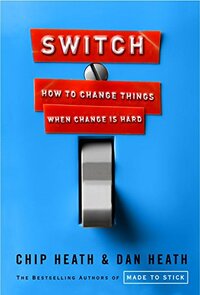You need to sign in or sign up before continuing.
Take a photo of a barcode or cover
Interesting concept. Understood it in the first few chapters, didn't need to read the whole book.
informative
reflective
medium-paced
I enjoyed this book as an audio book -- and was quite impressed with the way the book was structured. Even without taking notes -- I was up to my elbows in my annual fall tomato sauce processing -- I feel like I have absorbed the main points because of the redundant, cyclical nature of the book's structure.
The biggest challenge to implementing change is approached using the metaphor of the rider/elephant (ego/id). While most people begin to address changes with intellect and logic, you have to consider the emotion and passion that will cause any change effort to rise or fall.
To make a change successful - you have to consider both, because the elephant can quickly exhaust the rider and cause the change to fail. The authors present many excellent case studies -- which make it seem as though this model is easily applied in just about any situation. As they say, hindsight is 20/20 -- I'd love to be able to identify situations where someone seeking to create a change actively thought of it in terms of "rider/elephant." Perhaps the example of the "Designated Driver" campaign is one of those.
There are two key lessons for me from the book:
1. Bright Spots -- look at places where a change is successful, figure out why it is successful and expand that.
2. Identify environmental issues that contribute to a behavior you want to change -- person vs situation problem.
Much of the rest of the advice is not new to me -- such as SMART goals.
I'll refer you to Amir's excellent review if you want more details about the recommendations in the bok.
The biggest challenge to implementing change is approached using the metaphor of the rider/elephant (ego/id). While most people begin to address changes with intellect and logic, you have to consider the emotion and passion that will cause any change effort to rise or fall.
To make a change successful - you have to consider both, because the elephant can quickly exhaust the rider and cause the change to fail. The authors present many excellent case studies -- which make it seem as though this model is easily applied in just about any situation. As they say, hindsight is 20/20 -- I'd love to be able to identify situations where someone seeking to create a change actively thought of it in terms of "rider/elephant." Perhaps the example of the "Designated Driver" campaign is one of those.
There are two key lessons for me from the book:
1. Bright Spots -- look at places where a change is successful, figure out why it is successful and expand that.
2. Identify environmental issues that contribute to a behavior you want to change -- person vs situation problem.
Much of the rest of the advice is not new to me -- such as SMART goals.
I'll refer you to Amir's excellent review if you want more details about the recommendations in the bok.
I'm pretty sure these kind of books are made on an assembly line.
I'm not a big reader of this kind of book and it took me longer to finish than average. However I did enjoy the little stories of change which it tells and the book does achieve what it set out to do; I now have a good understanding of the framework that Chip and Dan came up with. Now I've just got to find somewhere I can apply it...
This book has been very eye-opening. It's very relatable and there are tons of easy to understand explanations and real-world anecdotes to make the concepts accessible to everyone. I suggest this read for those looking to make a change at home, work, or within yourself.
informative
inspiring
lighthearted
fast-paced
informative
fast-paced
soooo obsessed with weight and sexism it’s crazy. audiobook production is so shoddy. and they kept fucking saying “no dry holes”
informative
medium-paced





